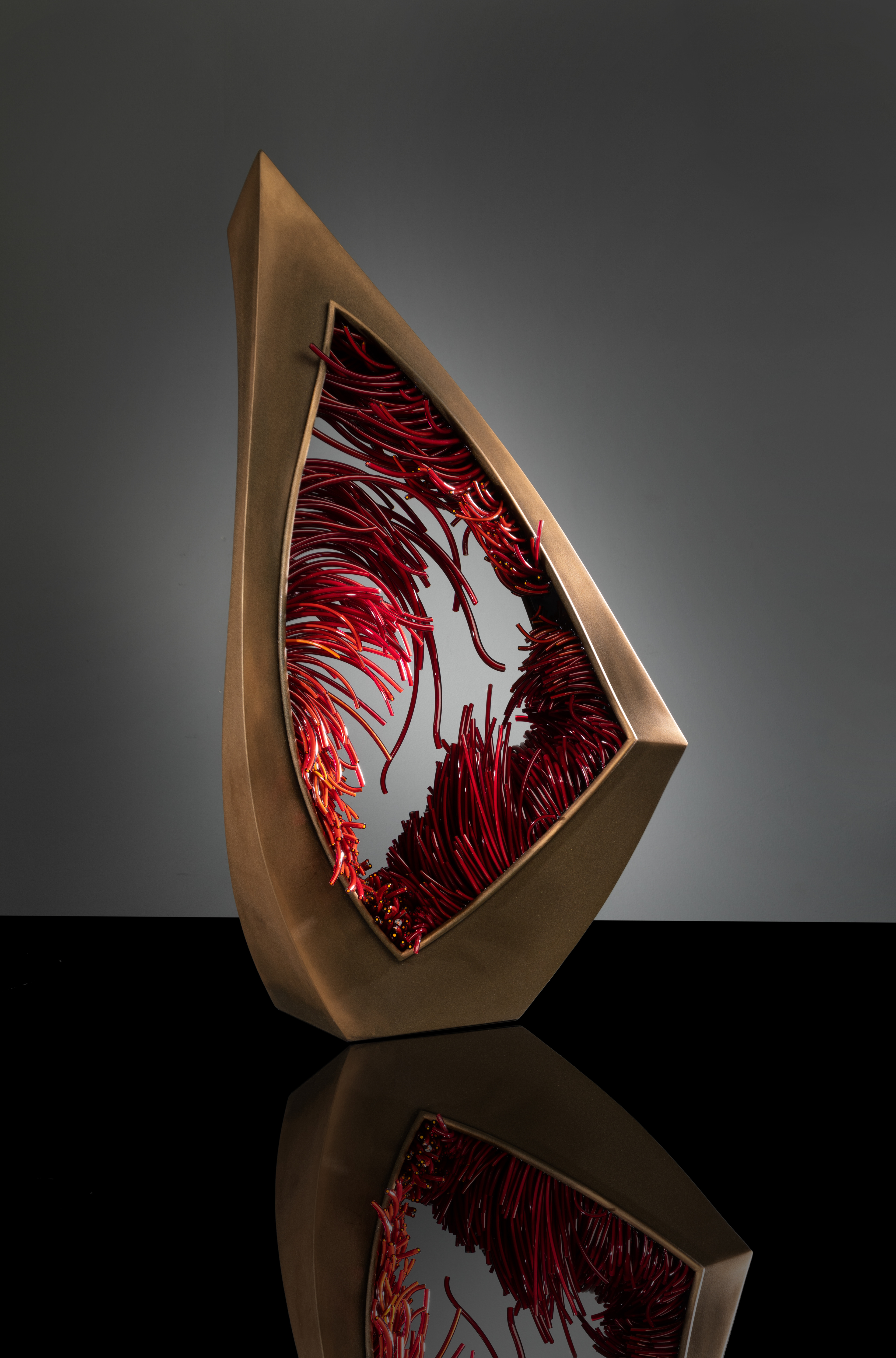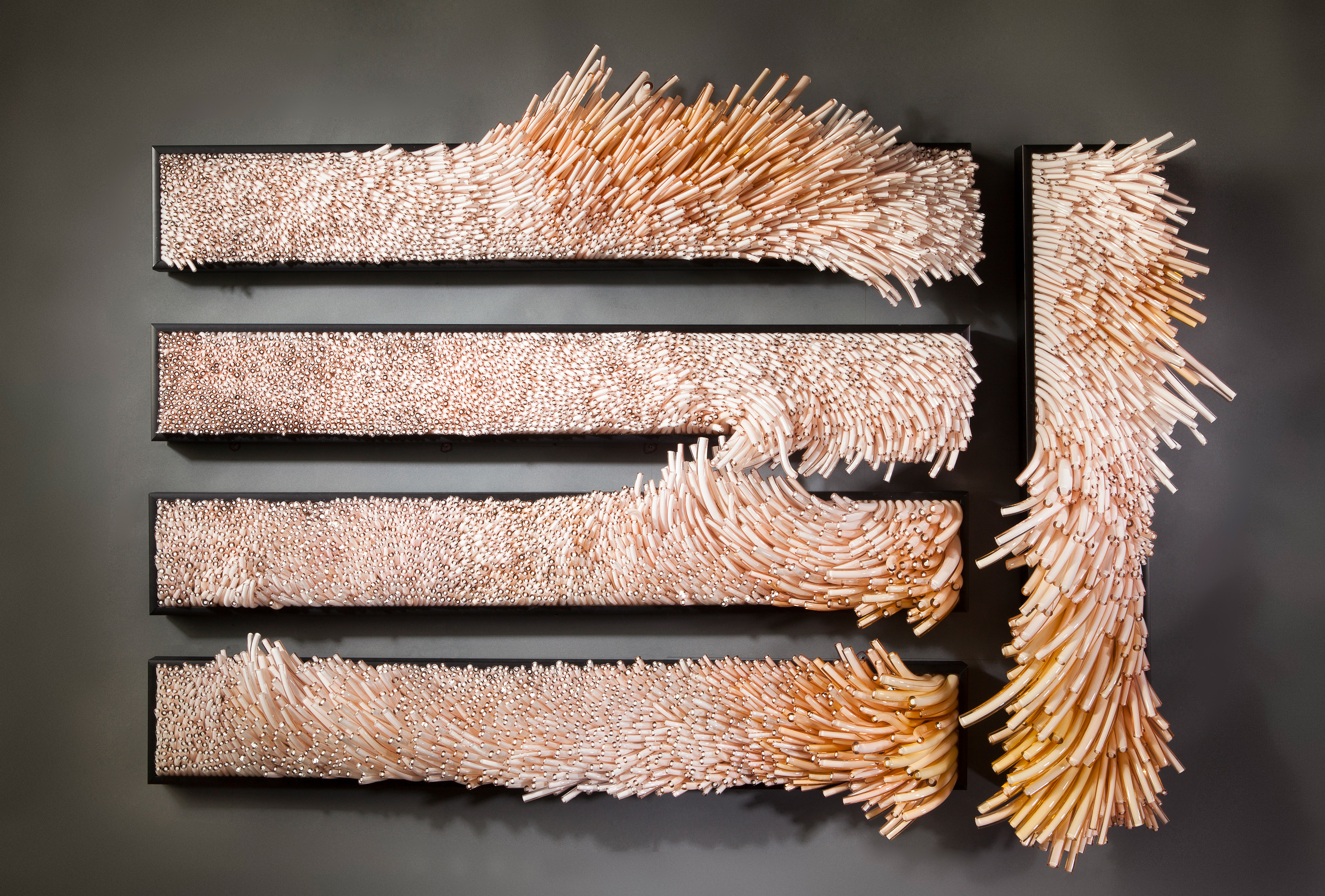_________________________
ITA - ENG
APRIL 2021
Shayna Leib is an artist who works with many materials but with a predilection for glass. With twenty years of experience behind, in her works, she often represents nature under the influence of two of the elements that most characterized her life: philosophy and music. In her works, the aspect she loves most about glass emerges: the ability to express frozen movement in an instant.
All images © courtesy of Shayna Leib and Eric Tadsen
Website: https://shaynaleib.com
____________________________


How did your artistic career start? Have you always thought about dedicating yourself to this type of career?
My artistic career began by chance, not design. I grew up drawing and working in ceramic, and pursued glass, sculpture, and painting in undergraduate studies. But I did not major in art. I studied European philosophy and Russian literature, graduating with my BA in philosophy and minors in literature and art. My university did not offer an art major at that time, so I took art classes as a way of breaking up studies in academia. I was on course to pursue my PhD in philosophy but had a change of heart and decided to apply for an MFA in fine art. To my surprise, I was accepted despite not having a BA in fine art. I attended the University of Wisconsin-Madison and concentrated my studies on glass and metal. The body of work I developed during that time was the beginning of the Wind & Water Series.
I moved around a bit after grad school, working as a goldsmith in Maine, and then going back to California to teach drawing and sculpture. While there, I began searching for jobs which focused more on glass and I landed an interview with an architectural glass company in Louisville, KY. They introduced me to a gallery in the same building that happened to be putting on an emerging artists exhibit. I submitted some of my grad school work and it sold. It was the first moment where I actually considered the possibility of working as a full-time artist. People are always told that few have what it takes to make it as a professional artist, so I hadn’t let myself dream in that direction until that moment. One sale turned into another, turned into a new gallery and then a career.
In your works you use different materials but glass is certainly the most used. Why did you choose such a material to represent a series like Wind and water?
Glass possesses an intrinsic fragility and ephemeral quality that most closely mimics the qualities of nature. The Wind and Water series focuses on frozen moments in time, where nature is captured in freeze-frame. Similarly, glass is suspended in motion through the cooling process from molten to solid. It was a perfect pairing.




Some of your works are structured on a two-dimensional wall, like a painting, from which your glass sculptures come out, why did you choose this type of representation?
I think the realm between 2D and 3D is under-utilized in art. My roots go back to drawing which begins and ends on the wall. But as I moved towards sculpture, I liked the presentation of having the art face the audience on the coronal plane, coming at them.
In one interview, you define music as a metaphor for your work. What do you mean by this sentence? What would be the perfect soundtrack capable of accompanying the visitor in your ideal exhibition?
Music is an assembly of sounds that can be experienced as a whole or as a part. The listener can switch their awareness between a single voice or instrument, to the sound of the entire orchestra. The best compositions balance a focus between minutiae and gestalt. I create art with the same focus on part-to-whole. I repeat elements in a landscape of movement, but each of the thousands of little pieces form different sections where they veer off in another direction, like a sub melody. Some of my work registers one way at a distance, but as you come closer, it gets more detailed, almost fractal, as each different element is still part of the whole but retains an individual uniqueness.
Early in the series (2000’s), I was listening to Philip Glass and Aphex Twin. I tend to create these days to Rachmaninoff or Holst. I can’t recommend a perfect soundtrack for my work but I can tell you what music I was listening to when I created the following pieces:
“Acadia”- Rachmaninoff’s the Bells and Wojciech Kilar
“Sunset over the Tundra”- Sasha’s Involver album. This piece is tied to memories of living on an island off the coast of Maine during winter and that soundtrack is the Involver album
“Stiniva 1”- Holst’s The Planets
“Break”- 90’s music like Limp Bizkit, Korn, Linkin Park (I was in a nostalgic cheesy mood)
“Harmattan”- Mozart’s Requiem
“Meltemi”- Beethoven’s 9th
When I’m making work in the hotshop (blowing glass) it’s Crystal Method, Chemical Brothers, Sub Swara, Modeselektor, Missy Elliot
When I’m grinding glass, it’s usually Jane’s Addiction or Led Zeppelin
When I’m lampworking, it’s usually 80’s or comedy
When I’m illustrating it’s Reggae
Music is never a benign experience for me like I think it is for a lot of people. I have a hard time in stores when it’s forced on me, or in a car with someone which is why I wouldn’t want a soundtrack to my exhibition. It evokes things that I’m sometimes not in the mood to experience, especially if I just want to be silly and carefree. But the upside of that is that it really defines sections of my life, and the feel of my work if I’m in the mood to let it do that. Often, I work to comedy or podcasts.
You often have told about the long process behind your glass works; I also find the choice of colors very interesting. Can you tell us about these aspects?
I use color in many ways, some quite literal, and some more interpretive. When I’m focusing on depicting a “Wind” piece and it is a cold wind, I choose white to depict snowy or frosty grasslands, or a slight yellowish hue to reflect the tone of the sun on snow as its rising or setting. (“Sunset Over the Tundra”). I use green for grasslands, and blue for water pieces in the hydrokinetic series. Sometimes the color is more interpretive, like yellows and oranges for warm winds which bring about a fire season (“Diablo”), or reds for pieces like “Harmattan” and “Scirocco” which are winds carrying red dust across deserts and dry grasslands. I use temperature of the water to also guide my color scheme. Pieces inspired by warm tropical waters get brighter hues, and those in colder waters get silvers, greens, and colder hues.




The Patisserie and Remnant series are truly amazing. How did the inspiration for these projects come about?
The Remnant series is the oldest of all my work and began in grad school. I had just moved to Wisconsin and was faced with a hunting culture, which was much different than the culture I grew up with in California. I had been a vegetarian and animal lover for 18 years and was trying to process the hunting and trapping culture of the Midwest. I saw value in animals not for what they could give you of their bodies, but in just being whole and alive. I began to create these fragile forms in glass which I then ate away at with the sandblaster for hours, creating a precious, empty, beautiful husk. It was a snapshot of that time in my life.
The Patisserie series was also personal to me as I was dealing with some severe food intolerances at the time I created the series. For about 6 years, I was only able to eat a dozen foods. The impact on my life was devastating and I was trying to cope with the loss. Ironically, choosing to create desserts out of glass and ceramic did something to my brain that helped me cope. I began to see food as form and dissect it with an artist’s eye. It made passing chocolate shops and dessert displays easier because I would immediately bypass my stomach and go into this mode of analyzing how I could depict it and what materials and techniques I needed to use. I also liked the idea of teasing my audience. There was a symmetry to it. It was unattainable satisfaction for both of us.
The Patisserie series was a real joy, despite the heaviness hidden behind it. I had so much energy for that series, especially the American part of it where I could add in some whimsy and humor. I tried a lot of techniques, and in some cases, I used my teeth to bite off chunks of clay (the bunny ears, bunny butt, and ice cream sandwich) so it kept things fun, experimental, and new. I made some desserts that were personal to me, like the frozen yogurt I used to get after a difficult orthodontist appointment- vanilla with gummy bears and raspberry with berries. I also got to really delve into every single aspect of glassmaking that I had learned over 25 years’ time, and bring back some techniques I hadn’t used for decades. I don’t think I could have pulled the American part of that series off at an earlier stage in my career, since it was dependent on too much amassed knowledge of so many techniques and materials.
Are there any artists from the past who have inspired you or also someone in the present that you particularly appreciate?
I have thousands of images in my collection of inspirational works, but there have only been a few which have really made an impact. Ryuhei Sako’s mokume gane works show a complete mastery over metal. Takahiro Kondo’s monolithic works with silver dew made me stop and stare for longer than I had in years. I admire the technique and labor of Hitomi Hosono’s porcelain vases. I am bonkers for Anna Barlow’s ceramic dessert masterpieces. I met her in a show we did together in France. Maude Bussieres’s glasswork is still something I think about on a regular basis. I tend to like a certain aesthetic that is rooted in the kind of craftsmanship and labor that underlies a deep knowledge and practice with a material. All those artists have a mastery that is taken to a different level. It’s not something the general public would be able to see, necessarily. It’s almost art for artists with what they manage to pull off.
What are you working on now?
I recently finished writing and illustrating a children’s book that took around 3 years to complete. The illustrations are very detailed, and quite a few took a month to create. It’s currently out for review by publishers. It was challenging to go back to my 2 Dimensional roots with colored pencils. While I’m proud of it, I am infinitely more comfortable with glass and ceramic.
I’m also working on a crossover body of work that combines some metal and glass. It’s a project for a local children’s museum in Madison.


